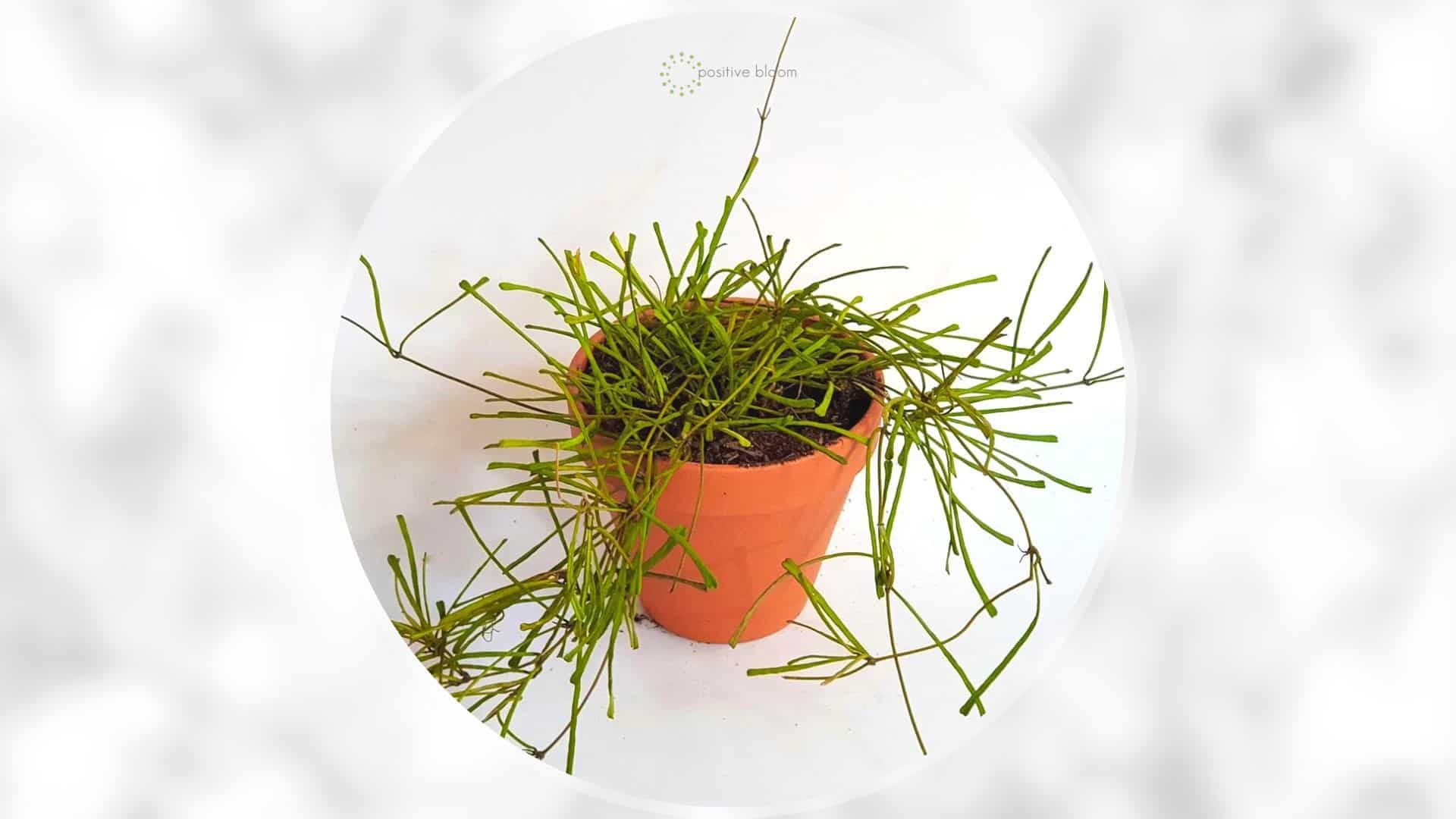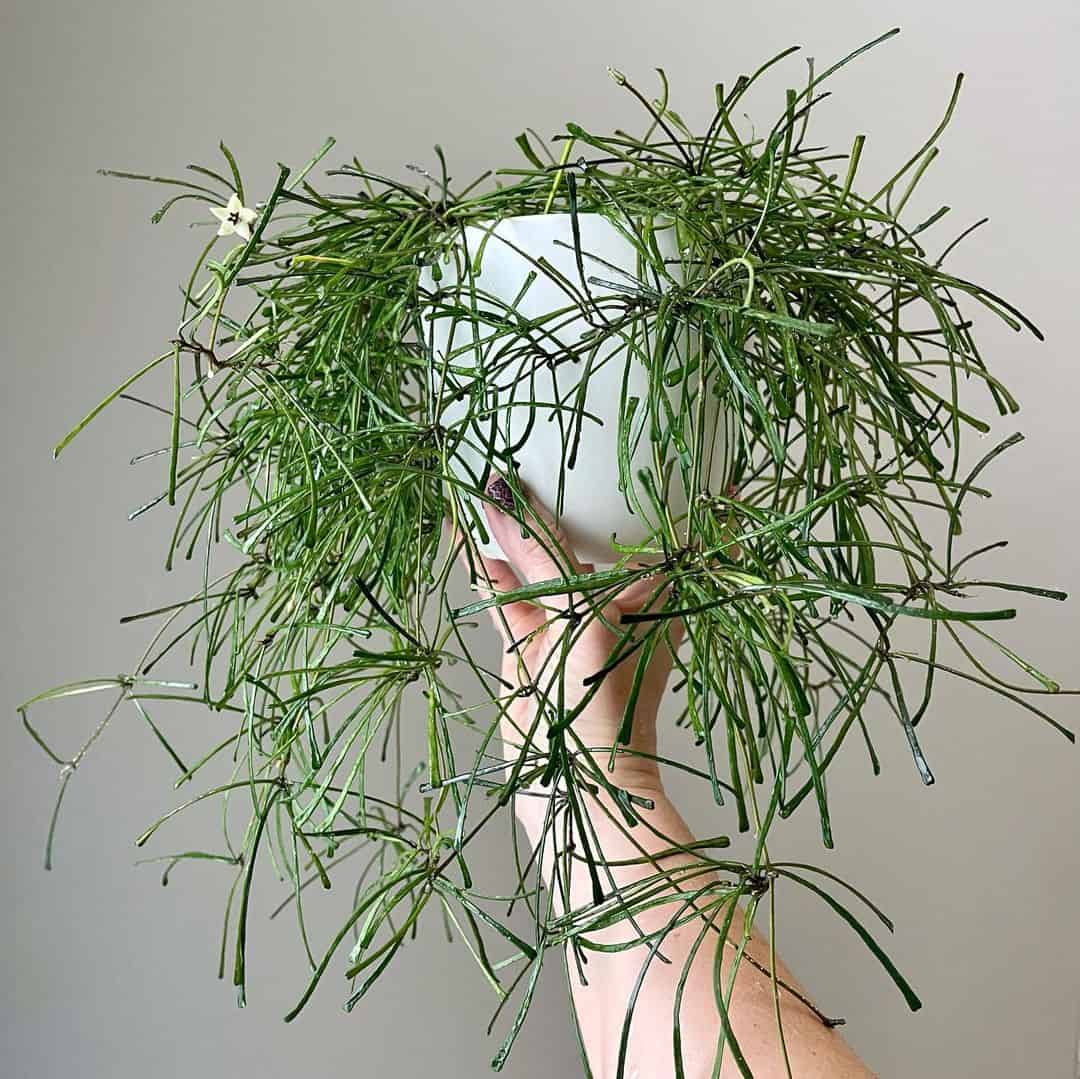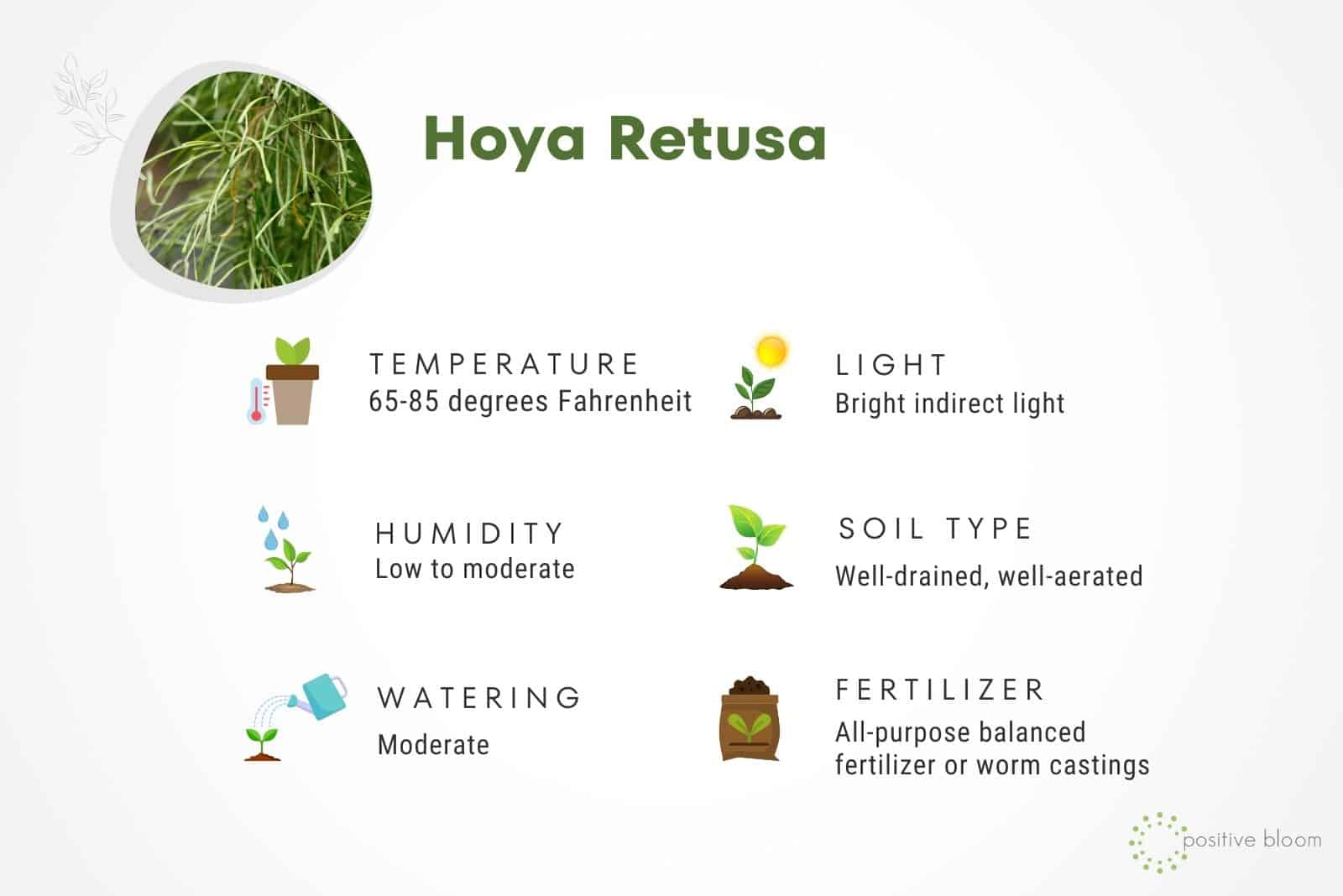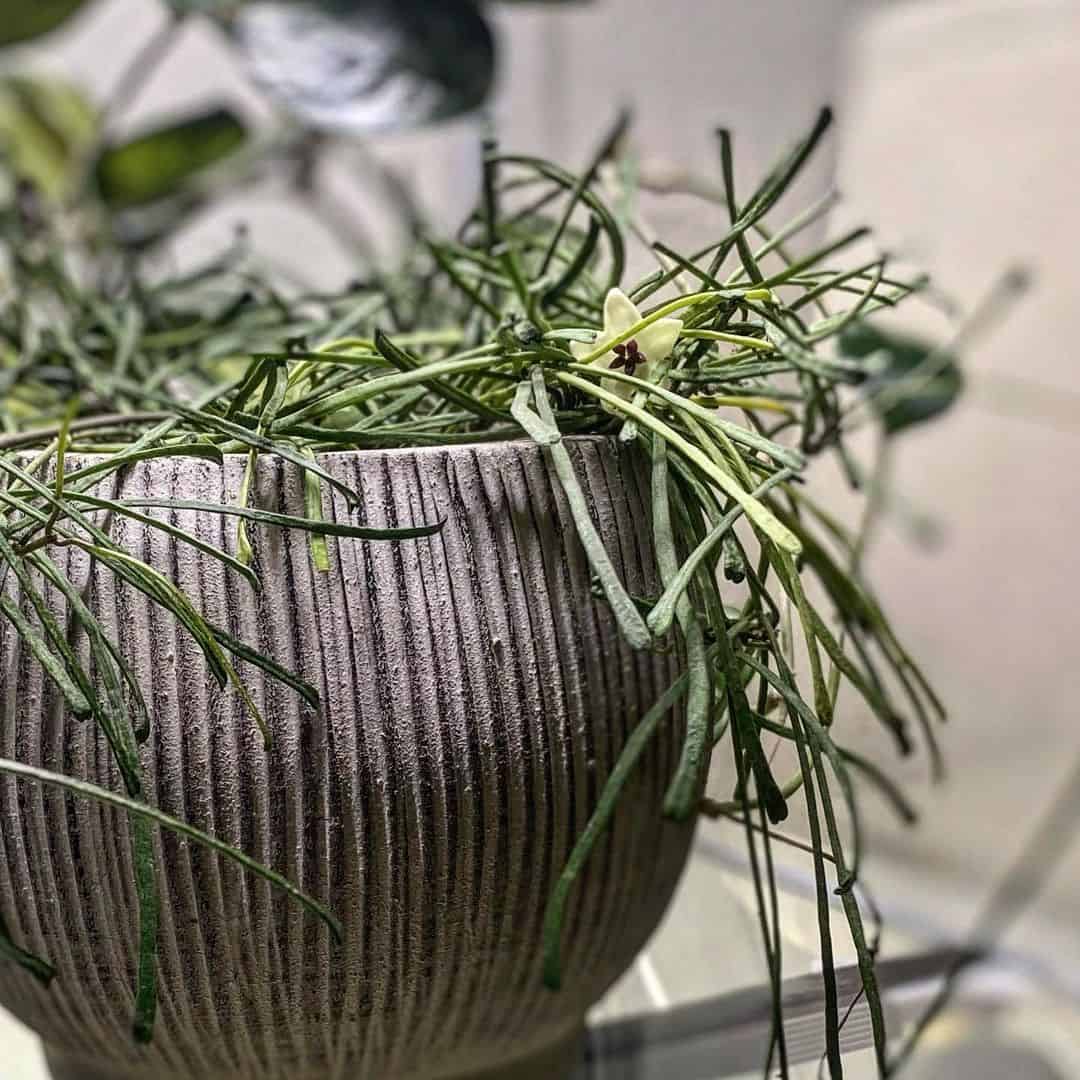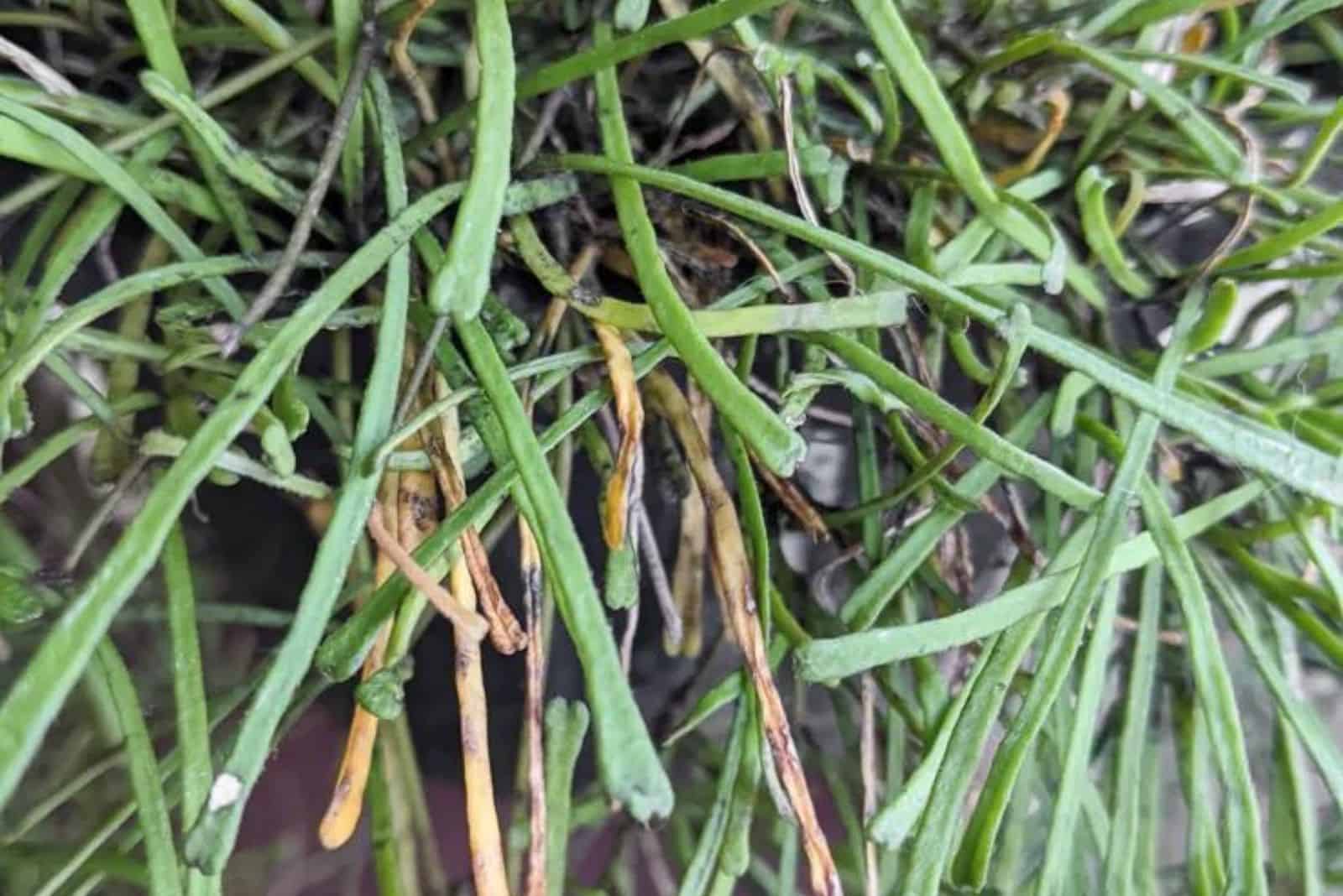I always thought that plants from the same genus looked similar and that the differences were, for instance, in flower color.
Now it’s kinda funny when I think of that since plants can be related in only a taxonomical sense.
One of the examples is the Hoya retusa, a lovely specimen from the Hoya genus. If you aren’t an experienced grower, you would never guess that the retusa species has anything to do with other Hoyas.
But there’s another interesting thing about this plant; it’s way more difficult to kill it than not only other Hoyas, but other plants in general.
In this article, I’ll tell you more about other features of this Hoya, how to care for and propagate it, and some common issues and how to fix them.
Here’s some basic info to get us started:
[table id=654 /]
What Is The Hoya Retusa?
The Hoya genus includes many lovely species, such as the Hoya lacunosa, Hoya macgillivrayi, Hoya gracilis, and the species I’m talking about today, the Hoya retusa.
What’s so special about the retusa species? This is a plant that you either love or hate; there’s nothing in between. It’s a pretty messy plant with unusual foliage, and it can be hard to find. I can’t really refer to it as a rare species, the term unpopular is probably more suitable.
The leaves of the retusa species are long and thin, and the plant resembles grass, hence the nickname “Grass-leafed hoya”.
It features numerous stems that look amazing when you grow the plant in a hanging basket.
Just like all other Hoya plants, the retusa produces star-shaped blossoms that develop into clusters. They come in white and are pinkish-red in the middle.
Why grow this Hoya species? First, it’s a low-maintenance plant that doesn’t need much to thrive. Second, the retusa plant will definitely stand out from other plants in your plant collection due to its unique growth habit. Third, you can quickly propagate your retusa and get babies without too much effort.
Finally, it’s a pet-friendly plant, so wherever you put it, you don’t need to worry that your dog or cat might get poisoned.
It can be pretty tricky to get the Grass-leafed hoya to bloom, but it’s not impossible; just follow the Hoya plant care guide below, and I’m sure it will reward you with gorgeous flowers.
Hoya Retusa Care Guide
What does the Grass-leafed plant need to thrive? Let’s find out!
Light Requirements
I purchased a Hoya retusa because no one had it at the time. Yes, I admit, it’s a pretty lame reason. I didn’t know much about Hoya light requirements, so I nearly killed a plant that has a reputation for being indestructible! Direct sun is probably the biggest enemy of the retusa plant.
If you want to avoid this scenario, give your Hoya a lot of bright indirect light. Burned and yellow foliage is a result of too much sun exposure, whereas poor growth is a result of low light.
So, you need a balance. A spot near a sunny window (east- or south-facing) will meet all Hoya retusa requirements regarding light.
Watering Schedule
Most species from the Hoya genus have succulent foliage, so their watering needs are low. The retusa species doesn’t respond well to completely dry soil, so you need to water it when you notice the topsoil is dry.
This means you’ll need to check on your plant more often to check soil moisture. Never water your Hoya when the topsoil is still wet; all Hoya retusa plant parents will agree that overwatering is the easiest way to kill this plant!
Put your finger or a wooden stick in the growing medium and check the moisture; if the top 2-3 inches are dry, irrigate your Hoya.
Your retusa will need more frequent irrigation during the hot summer months and less water during the winter.
Humidity Requirements
Hoyas aren’t finicky about humidity levels; anything higher than 40% and lower than 60% will suffice.
I keep humidity near my Hoyas at around 50% and they are doing pretty well.
Remember that low humidity levels may decrease the retusa’s watering needs, so you can end up with overwatered plants quickly if you’re not careful.
If the humidity in your apartment is slightly lower than 40%, put a pebble tray below the pot or mist your Hoya regularly.
If you don’t have a clue about the humidity level in your apartment, you can install a humidifier that controls and measures humidity at the same time.
It’s pricey, but it’s a long-term solution!
The Ideal Temperature
Your Hoya retusa plant thrives in temperatures ranging from 65 to 85 degrees Fahrenheit. Frost tolerance isn’t a feature of this species, so you should never expose the plant to temperatures lower than 50%.
High temperatures affect the Hoya’s watering needs, so the higher the temperature, the more water your Hoya will need.
Temperatures over 85 degrees will cause your Hoya to display poor growth.
Avoid spots near heating devices, air conditioners, and drafty windows because they pose a serious threat to your Hoya’s life.
Soil
The key to healthy Hoya retusa growth lies in well-draining and porous soil. Since the plant is sensitive to overwatering, you need to make sure that all excess water drains out of the growing substrate.
Even though a succulent soil mix might sound like a good option due to excellent drainage, your retusa can’t be cultivated in that soil type.
The reason is pretty simple; succulent soil mix drains out quickly and Hoya plants need moisture to grow healthy.
I use standard potting soil and amend it with coco coir and perlite. I’m not thrifty when it comes to perlite because it’s the ingredient that’s best for drainage.
Fertilizing Schedule
When someone asks me about Hoyas, fertilizing is the last thing I talk about. I mean, the retusa plant will benefit from feeding, but too much will do more harm than good.
Even though all-purpose balanced fertilizer works perfectly for Hoyas, I use organic versions such as worm castings. Coffee grounds and houseplants are also a great combo.
Pruning
Generally speaking, you don’t need to prune your Hoya retusa, BUT… if you let your Grass leafed hoya grow uncontrollably it would take over your apartment.
Yes, I’m exaggerating a little bit, but this Hoya produces a lot of stems and leaves, and if you don’t prune them from time to time, the plant will end up looking messy.
The foliage can also be damaged or diseased, and pruning is the best way to avoid further issues.
Potting And Repotting
The Grass leafed hoya has a moderate growth rate, so you won’t need to repot it very often. You can repot every two years to refresh the nutrients, or wait 1-2 more if the Hoya plant seems happy and healthy.
Honestly, I wait as long as possible since it’s hard to handle so many stems and leaves; why do it if it isn’t necessary?
Before you start repotting your Hoya retusa, prepare a new container (slightly larger), fresh soil mix, and a pair of scissors to remove any diseased roots you might find.
Gently remove your Grass leafed hoya from its container, clean the root system, replant it in a new container filled with potting mix, and irrigate well.
How To Propagate The Hoya Retusa Plant
Propagation is definitely my favorite part of growing the Grass leafed hoya plant, which produces so many stems that it’s very hard to fail when it comes to taking a cutting.
Dip a sharp knife into a sanitizing solution to prevent contamination, and cut a 6-inch long section of Hoya stem with a few nodes.
You can use water or soil as a rooting medium for your Grass leafed hoya stem cutting. Water is probably a better choice for beginner growers since it gives you an insight into root formation.
Pour some fresh water into a glass jar and put the Hoya cutting in it. Once the roots are 1-2 inches long, you can repot your new retusa hoya in soil.
If you use soil as a rooting medium, you’ll know it’s time for transplantation when the Hoya cutting shows resistance when you (gently) pull it.
Here’s a video on how to propagate the Hoya retusa plant:
Common Issues With The Grass Leafed Hoya
I live in constant fear that something bad might happen to my plants, so I inspect them all the time. Unfortunately, issues can occur and the Hoya retusa isn’t a problem-free plant (if there’s such a plant, please contact me).
Let’s find out more!
Pests And Diseases
Spider mites and aphids love feeding on the Grass-leafed hoya, so you need to watch out for these annoying creatures.
If you notice honeydew or webbing on the Hoya retusa leaves, you might be dealing with pests. Treat your Grass leafed hoya with insecticidal soap or neem oil solution.
Unfortunately, root rot is a common disease in the Hoya retusa plant that happens as a result of overwatering.
If your Hoya has root rot, its leaves will turn yellow, the soil will become mushy and smell awful, and the plant will display poor or no growth.
The best way to fix root rot in a Hoya is to repot the plant and remove the affected roots.
Deformation And Discoloration
If your retusa plant starts wilting and the leaves start curling and turning brown, the plant might lack water or be receiving too much light.
Check the moisture content in the growing medium and make sure to place your Hoya where it can receive bright indirect light.
If your Hoya is really pale and droopy, it is most likely lacking light. Introduce it to more light ASAP (not direct).
Wrapping Up
Growing unusual plants has always been my passion. The Hoya retusa, aka Grass leafed hoya, is a lovely species native to Southeastern Asia.
The plant has it all: it’s super easy to maintain and propagate, non-toxic, and produces blossoms.
I especially recommend this Hoya to beginner growers and those who are propagating for the first time.
Until next time!

